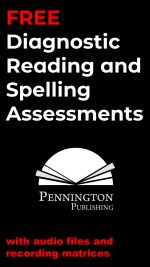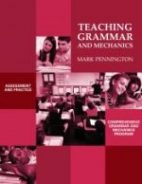Spelling Assessment Questions and Answers
I love spelling instruction. Not the give the pretest on Monday; give ’em a crossword puzzle of the words on Tuesday; give ’em a word search on Wednesday; tell ’em to study on Thursday; and test ’em on the same words Friday kind of spelling instruction.
I love the kind of grade-level spelling instruction that sticks with kids (and adults). The kind that makes use of our alphabetic code; the kind that uses spelling patterns and values “spelling rules” (which do work most of the time); the kind that uses a problem-solving approach to word analysis (yes… spelling sorts); the kind that does hold students accountable for spelling errors in their own writing; and the kind that makes use of the Monday pretest as a diagnostic instrument and the Friday posttest as a formative assessment.
That said, as an author of numerous spelling programs and an often-used Diagnostic Spelling Assessment, I get two questions quite frequently: 1. Does a diagnostic spelling assessment make sense? and 2. How can we use the weekly pretest as a diagnostic assessment? But I’ll let teachers ask those questions in their own words…
1. How can teachers address spelling needs for students who are spelling at a grade 1/2 level and are in grade 5/6? How would you give the diagnostic test to these low level students who cannot even spell “rag” or “top?”
RESPONSE: Great question! An effective diagnostic spelling assessment has to isolate and test specific sound-spellings. The trick is to do so with words which assess specific student knowledge about that spelling pattern and nothing else.
With most remedial spellers, such as your hypothetical 5/6 student, these students have had to develop a quite sophisticated set of coping mechanisms and survival skills to be able to read and/or spell anything at all. These students have become sight-word dependent, using word recognition skills, rather than word identification skills to memorize individual spelling words. In all likelihood the student has learned to read via “Dick and Jane” look-say methods or onset-rhyme techniques, rather than through explicit and systematic phonics instruction. But not necessarily. An effective diagnostic spelling assessment has to isolate that variable to really assess what needs to be assessed.
In your question you refer to the short a, as in “rag,” and the short o as in “top.” Rather than use these words as test items (which most 5/6 students would know), a good assessment uses multisyllabic words to isolate and assess those sound-spellings to isolate the variable of sight-spelling knowledge. That’s good internal and external validity in assessment-speak.
The author of this article has such a comprehensive diagnostic assessment (See author tag below for links) to address this issue. For example, the first spelling word on the assessment is “bumper.” The word “bumper” is used, rather than “bump” or “bun” to assess the short u because most remedial spellers, such as your 5/6 student will not know this word as a sight-spelling.
In correcting that item, the teacher is instructed only to correct the short vowel u. So if the student spells “bumpr,” than it is correct. Another spelling test item will catch the “er” spelling deficit.
2. What’s the use of giving a spelling pretest if the posttest is the same list of words?
June 3, 2012
RESPONSE: I agree with your sentiments. The pretest is a waste of time, unless we make use of it as a diagnostic assessment. Furthermore (I’ve always wanted to use that transition), giving a posttest of the same words is just silly. Why should students have to practice and study, then be re-tested on words they already know? Here’s how to make sense of both the spelling pretest and spelling posttest:
1. Administer the weekly pretest.
2. After completing this diagnostic pretest, display the spelling words and direct students to self-correct their spelling errors by circling the misspelled sound-spellings.
3. Have students create their own Personal Spelling List of 15 words and have a parent sign the list. Students complete the Personal Spelling List in this priority order:
- Pretest Errors: Have students write the spelling words they missed on the pretest.
- Posttest Errors: Have students write the words they missed on the last posttest.
- Writing Errors: Have students add on teacher-corrected spelling errors found in their own writing.
- Supplemental Spelling Lists: Students add on unknown words from non-phonetic outlaw words, commonly confused homonyms, spelling demons, and high frequency lists.
4. On the next class day briefly explain the spelling pattern focus of the pretest. My bias (and that of the Common Core authors in the appendices) is that we should be teaching grade-level spelling patterns, not silly themed word lists. If using a spelling patterns pretest, help students learn and problem-solve the patterns through a spelling sort. Avoid useless crossword puzzles, word searches, and write each word ten times approaches. Please.
5. Students study their Personal Spelling List(s) for the spelling formative posttest. Many teachers elect to give the spelling posttest at the end of the week; others choose to combine two spelling patterns lessons and include these as part of the bi-weekly unit test. I give a bi-weekly test of two Personal Spelling Lists to save class time. There is no law saying that you have to test each Friday.
6. To administer the weekly or bi-weekly posttest, direct students to take out a piece of binder paper, find a partner, and exchange dictation of their Personal Spelling List(s) words (10‒20 Minutes weekly or bi-weekly). Students then turn in their posttests for the teacher to grade. I know… you think they’ll cheat. In my experience, very few do. Also… this works with second graders (I’ve done it) on up.
A Model Grades 4-8 Spelling Scope and Sequence
Preview the Grades 4-8 Spelling Scope and Sequence tied to the author’s comprehensive grades 4-8 Language Strand programs. The instructional scope and sequence includes grammar, usage, mechanics, spelling, and vocabulary. Teachers and district personnel are authorized to print and share this planning tool, with proper credit and/or citation. Why reinvent the wheel? Also check out my articles on Grammar Scope and Sequence, Mechanics Scope and Sequence, and Vocabulary Scope and Sequence.
FREE DOWNLOAD TO ASSESS THE QUALITY OF PENNINGTON PUBLISHING AMERICAN ENGLISH AND CANDADIAN ENGLISH SPELLING PROGRAMS. Check out these grades 4-8 programs HERE. Administer my FREE comprehensive Diagnostic Spelling Assessment with audio file and recording matrix. It has 102 words (I did say comprehensive) and covers all common spelling patterns and conventional spelling rules. It only takes 22 minutes and includes an audio file with test administration instructions. Once you see the gaps in your middle school students spelling patterns, you’re going to want to fill those gaps.
Get the Diagnostic Spelling Assessment, Mastery Matrix, and Sample Lessons FREE Resource:
![]()
Literacy Centers, Reading, Spelling/Vocabulary, Study Skills











